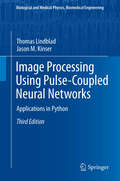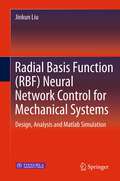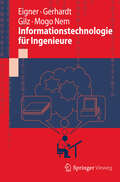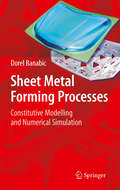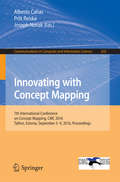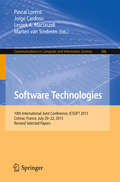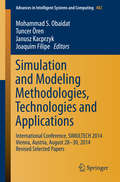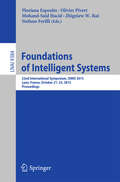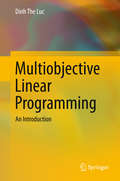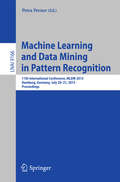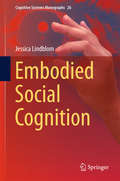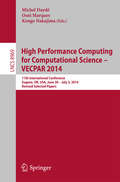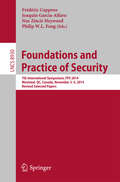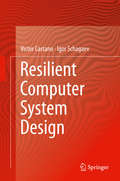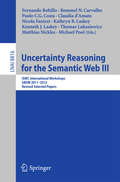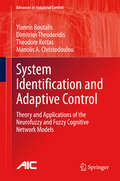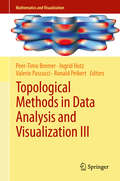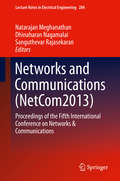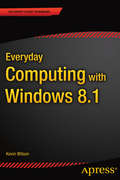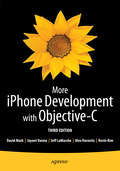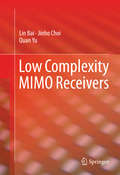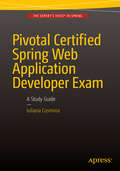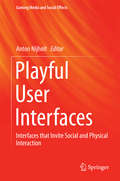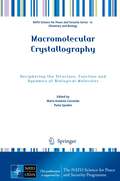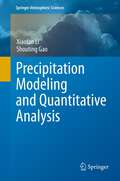- Table View
- List View
Image Processing using Pulse-Coupled Neural Networks: Applications in Python
by Thomas Lindblad Jason M. KinserImage processing algorithms based on the mammalian visual cortex are powerful tools for extraction information and manipulating images. This book reviews the neural theory and translates them into digital models. Applications are given in areas of image recognition, foveation, image fusion and information extraction. The third edition reflects renewed international interest in pulse image processing with updated sections presenting several newly developed applications. This edition also introduces a suite of Python scripts that assist readers in replicating results presented in the text and to further develop their own applications.
Radial Basis Function (RBF) Neural Network Control for Mechanical Systems
by Jinkun LiuRadial Basis Function (RBF) Neural Network Control for Mechanical Systems is motivated by the need for systematic design approaches to stable adaptive control system design using neural network approximation-based techniques. The main objectives of the book are to introduce the concrete design methods and MATLAB simulation of stable adaptive RBF neural control strategies. In this book, a broad range of implementable neural network control design methods for mechanical systems are presented, such as robot manipulators, inverted pendulums, single link flexible joint robots, motors, etc. Advanced neural network controller design methods and their stability analysis are explored. The book provides readers with the fundamentals of neural network control system design. This book is intended for the researchers in the fields of neural adaptive control, mechanical systems, Matlab simulation, engineering design, robotics and automation. Jinkun Liu is a professor at Beijing University of Aeronautics and Astronautics.
Informationstechnologie für Ingenieure
by Torsten Gilz Martin Eigner Fabrice Mogo Nem Florian GerhardtTechnische Produkte sind heute komplexe Systeme, die von mehreren Ingenieurdisziplinen gemeinsam entwickelt werden. Deshalb gehört die Informationstechnologie zum Ausbildungscurriculum von Ingenieuren. In dem Buch werden technische Anwendungssysteme für die Entwicklung (Computer Aided Design), die Berechnung und Simulation (Computer Aided Engineering), die Administration (Product Lifecycle Management) und die Visualisierung vorgestellt. Auch der mechatronische Produktentwicklungsprozess und die Softwareerstellung werden detailliert erläutert.
Sheet Metal Forming Processes
by Dorel BanabicThe book gives a synthetic presentation of the research performed in the field of sheet metal forming simulation during more than twenty years by the members of three teams: the Research Centre on Sheet Metal Forming - CERTETA (Technical University of Cluj-Napoca, Romania); AUTOFORM software-house company from Zürich, Switzerland and VOLVO automotive company from Sweden. The first chapter reminds some fundamental topics of the theory of plasticity. A more extended chapter is devoted to the presentation of the phenomenological yield criteria, emphasizing the formulations proposed by the CERTETA team (BBC models). The sheet metal formability is discussed in a separate chapter. After presenting the methods used for the formability assessment, the discussion focuses on the forming limit curves. In this context, the authors emphasize their contributions to the mathematical modeling of forming limit curves. The aspects related to the implementation of the constitutive models in finite-element codes are discussed in the last chapter of the book. The performances of the models are proved by the numerical simulation of various sheet metal forming processes: hydroforming, deep-drawing and forming of the complex parts. The book is useful for the students, doctoral fellows, researchers and engineers who are mainly interested in the mechanical modeling and numerical simulation of sheet metal forming processes. Modeling and numerical simulation of sheet metal forming processes.
Innovating with Concept Mapping
by Alberto Cañas Priit Reiska Joseph NovakThis book constitutes the refereed proceedings of the 7th International Conference on Concept Mapping, CMC 2016, held in Tallinn, Estonia, in September 2016. The 25 revised full papers presented were carefully reviewed and selected from 135 submissions. The papers address issues such as facilitation of learning; eliciting, capturing, archiving, and using expert knowledge; planning instruction; assessment of deep understandings; research planning; collaborative knowledge modeling; creation of knowledge portfolios; curriculum design; eLearning, and administrative and strategic planning and monitoring. "
Software Technologies
by Marten Van Sinderen Leszek A. Maciaszek Jorge Cardoso Pascal LorenzThis bookconstitutes the thoroughly refereed proceedings of the 10th International JointConference on Software Technologies, ICSOFT 2015, held in Colmar, France, inJuly 2015. The 23revised full papers presented were carefully reviewed and selected from 117submissions. The papers are organized around the following conference tracks:enterprise software technologies; software project management; softwareengineering methods and techniques; distributed and mobile software systems.
Simulation and Modeling Methodologies, Technologies and Applications
by Mohammad S. Obaidat Joaquim Filipe Janusz Kacprzyk Tuncer ÖrenThepresent book includes a set of selected extended papers from the 5thInternational Conference on Simulation and Modeling Methodologies, Technologiesand Applications (SIMULTECH 2015), held in Colmar, France, from 21 to 23 July2015. The conference brought together researchers, engineers and practitionersinterested in methodologies and applications of modeling and simulation. Newand innovative solutions are reported in this book. SIMULTECH 2015 received 102submissions, from 36 countries, in all continents. After a double blind paperreview performed by the Program Committee, 19% were accepted as full papers andthus selected for oral presentation. Additional papers were accepted as shortpapers and posters. A further selection was made after the Conference, basedalso on the assessment of presentation quality and audience interest, so thatthis book includes the extended and revised versions of the very best papers ofSIMULTECH 2015. Commitment to high quality standards is a major concern of SIMULTECHthat will be maintained in the next editions, considering not only thestringent paper acceptance ratios but also the quality of the programcommittee, keynote lectures, participation level and logistics.
Foundations of Intelligent Systems
by Stefano Ferilli Olivier Pivert Floriana Esposito Mohand-Said Hacid Zbigniew W. RásThis book constitutes the refereed proceedings of the 22ndInternational Symposium on Methodologies for Intelligent Systems, ISMIS 2015,held in Lyon, France, in October 2015. The 31 revised full papers presented together with 18short papers were carefully reviewed and selected from 67 submissions. Thepapers are organized in topical sections on data mining methods; databases,information retrieval, recommender systems; machine learning; knowledgerepresentation, semantic web; emotion recognition, music information retrieval;network analysis, multi-agent systems; applications; planning, classification;and textual data analysis and mining.
Multiobjective Linear Programming
by Dinh The LucThis book introduces the reader to the field of multiobjective optimization through problems with simple structures, namely those in which the objective function and constraints are linear. Fundamental notions as well as state-of-the-art advances are presented in a comprehensive way and illustrated with the help of numerous examples. Three of the most popular methods for solving multiobjective linear problems are explained, and exercises are provided at the end of each chapter, helping students to grasp and apply key concepts and methods to more complex problems. The book was motivated by the fact that the majority of the practical problems we encounter in management science, engineering or operations research involve conflicting criteria and therefore it is more convenient to formulate them as multicriteria optimization models, the solution concepts and methods of which cannot be treated using traditional mathematical programming approaches.
Machine Learning and Data Mining in Pattern Recognition
by Petra PernerThis book constitutes the refereed proceedings of the 11th International Conference on Machine Learning and Data Mining in Pattern Recognition, MLDM 2015, held in Hamburg, Germany in July 2015. The 41 full papers presented were carefully reviewed and selected from 123 submissions. The topics range from theoretical topics for classification, clustering, association rule and pattern mining to specific data mining methods for the different multimedia data types such as image mining, text mining, video mining and Web mining.
Embodied Social Cognition
by Jessica LindblomThis book clarifies the role and relevance of the body in social interaction and cognition from an embodied cognitive science perspective. Theories of embodied cognition have during the last decades offered a radical shift in explanations of the human mind, from traditional computationalism, to emphasizing the way cognition is shaped by the body and its sensorimotor interaction with the surrounding social and material world. This book presents a theoretical framework for the relational nature of embodied social cognition, which is based on an interdisciplinary approach that ranges historically in time and across different disciplines. It includes work in cognitive science, artificial intelligence, phenomenology, ethology, developmental psychology, neuroscience, social psychology, linguistics, communication and gesture studies. The theoretical framework is illustrated by empirical work that provides some detailed observational fieldwork on embodied actions captured in three different episodes of spontaneous social interaction and cognition in situ. Furthermore, the theoretical contributions and implications of the study of embodied social cognition are discussed and summed up. Finally, the issue what it would take for an artificial system to be socially embodied is addressed and discussed, as well as the practical relevance for applications to artificial intelligence (AI) and socially interactive technology.
High Performance Computing for Computational Science -- VECPAR 2014
by Michel Daydé Osni Marques Kengo NakajimaThis book constitutes the thoroughly refereed post-conference proceedings of the 11th International Conference on High Performance Computing for Computational Science, VECPAR 2014, held in Eugene, OR, USA, in June/July 2014. The 25 papers presented were carefully reviewed and selected of numerous submissions. The papers are organized in topical sections on algorithms for GPU and manycores, large-scale applications, numerical algorithms, direct/hybrid methods for solving sparse matrices, performance tuning. The volume also contains the papers presented at the 9th International Workshop on Automatic Performance Tuning.
Foundations and Practice of Security
by Frédéric Cuppens Joaquin Garcia-Alfaro Nur Zincir Heywood Philip W. L. FongThis book constitutes the thoroughly refereed post-proceedings of the 7th Symposium on Foundations and Practice of Security, FPS 2014, held in Montreal, QC, Canada, in November 2014. The 18 revised full papers presented together with 5 short papers and 2 position papers were carefully reviewed and selected from 48 submissions. The papers are organized in topical sections on privacy; software security and malware analysis; network security and protocols; access control models and policy analysis; protocol verification; and cryptographic technologies.
Resilient computer system design
by Igor Schagaev Victor CastanoThis book presents a paradigm for designing new generation resilient and evolving computer systems, including their key concepts, elements of supportive theory, methods of analysis and synthesis of ICT with new properties of evolving functioning, as well as implementation schemes and their prototyping. The book explains why new ICT applications require a complete redesign of computer systems to address challenges of extreme reliability, high performance, and power efficiency. The authors present a comprehensive treatment for designing the next generation of computers, especially addressing safety critical, autonomous, real time, military, banking, and wearable health care systems.
Uncertainty Reasoning for the Semantic Web III
by Fernando Bobillo Rommel N. Carvalho Paulo C. G. Costa Claudia D'Amato Nicola Fanizzi Kathryn B. Laskey Kenneth J. Laskey Thomas Lukasiewicz Matthias Nickles Michael PoolThis book contains revised and significantly extended versions of selected papers from three workshops on Uncertainty Reasoning for the Semantic Web (URSW), held at the International Semantic Web Conferences (ISWC) in 2011, 2012, and 2013. The 16 papers presented were carefully reviewed and selected from numerous submissions. The papers included in this volume are organized in topical sections on probabilistic and Dempster-Shafer models, fuzzy and possibilistic models, inductive reasoning and machine learning, and hybrid approaches.
System Identification and Adaptive Control
by Yiannis Boutalis Dimitrios Theodoridis Theodore Kottas Manolis A. ChristodoulouPresenting current trends in the development and applications of intelligent systems in engineering, this monograph focuses on recent research results in system identification and control. The recurrent neurofuzzy and the fuzzy cognitive network (FCN) models are presented Both models are suitable for partially-known or unknown complex time-varying systems. Neurofuzzy Adaptive Control contains rigorous proofs of its statements which result in concrete conclusions for the selection of the design parameters of the algorithms presented. The neurofuzzy model combines concepts from fuzzy systems and recurrent high-order neural networks to produce powerful system approximations that are used for adaptive control. The FCN model stems from fuzzy cognitive maps and uses the notion of "concepts" and their causal relationships to capture the behavior of complex systems. The book shows how, with the benefit of proper training algorithms, these models are potent system emulators suitable for use in engineering systems All chapters are supported by illustrative simulation experiments, while separate chapters are devoted to the potential industrial applications of each model including projects in: * contemporary power generation; * process control and * conventional benchmarking problems. Researchers and graduate students working in adaptive estimation and intelligent control will find Neurofuzzy Adaptive Control of interest both for the currency of its models and because it demonstrates their relevance for real systems. The monograph also shows industrial engineers how to test intelligent adaptive control easily using proven theoretical results.
Topological Methods in Data Analysis and Visualization III
by Peer-Timo Bremer Ingrid Hotz Valerio Pascucci Ronald PeikertThis collection of peer-reviewed conference papers provides comprehensive coverage of cutting-edge research in topological approaches to data analysis and visualization. It encompasses the full range of new algorithms and insights, including fast homology computation, comparative analysis of simplification techniques, and key applications in materials and medical science. The volume also features material on core research challenges such as the representation of large and complex datasets and integrating numerical methods with robust combinatorial algorithms. Reflecting the focus of the TopoInVis 2013 conference, the contributions evince the progress currently being made on finding experimental solutions to open problems in the sector. They provide an inclusive snapshot of state-of-the-art research that enables researchers to keep abreast of the latest developments and provides a foundation for future progress. With papers by some of the world's leading experts in topological techniques, this volume is a major contribution to the literature in a field of growing importance with applications in disciplines that range from engineering to medicine.
Networks and Communications (NetCom2013)
by Natarajan Meghanathan Dhinaharan Nagamalai Sanguthevar RajasekaranThis book covers theory, methodology and applications of computer networks, network protocols and wireless networks, data communication technologies, and network security. The book is based on the proceedings from the Fifth International Conference on Networks & Communications (NetCom). The proceedings will feature peer-reviewed papers that illustrate research results, projects, surveys and industrial experiences that describe significant advances in the diverse areas of computer networks & communications.
Everyday Computing with Windows 8.1
by Kevin WilsonGet the most out of Windows 8. 1 for your every day computing tasks, with no jargon. Clear, concise and to the point. This brief book, Everyday Computing With Windows 8. 1 provides the essentials of using a desktop or laptop running Windows 8 or 8. 1, providing a fast read for the beginner and the enthusiast. Windows 8 can give new users fits with options that are well hidden; this book uncovers those so that the user can be relieved of frustration. Techniques are illustrated step-by-step using photography and screen prints throughout, together with concise, easy to follow explanations from an established expert in the field. Whether you have just bought your first computer or laptop or are a computer user who needs a better understanding of the basics, this book will provide you with a firm grasp of the underpinning foundations and equip you with the skills needed to take command of your computer.
More iPhone Development with Objective-C
by Alex Horovitz David Mark Jayant Varma Jeff Lamarche Kevin KimIf you are looking to extend your iOS programming skills beyond the basics then More iPhone Development with Objective-C is for you. Authors Dave Mark, Jayant Varma, Jeff LaMarche, Alex Horovitz, and Kevin Kim explain concepts as only they can--with code snippets you can customize and use, as you like, in your own apps. More iPhone Development with Objective-C is an independent companion to Beginning iPhone Development with Objective-C. That is, it is a perfect second book, but it is also a great book for those looking to improve their skills who have already programmed for iOS. In particular it includes a series of chapters devoted to Core Data, the standard for Apple persistence. The authors carefully step through each Core Data concept and show techniques and tips specifically for writing larger apps--offering a breadth of coverage you won't find anywhere else. More iPhone Development with Objective-C covers a variety of other topics, including Multipeer Connectivity's relatively simple Bluetooth/WiFi peer-to-peer model, MapKit, and media library access and playback so that your applications can utilize media on your users' computer. You'll also find coverage of Interface Builder, Live Previews and Custom Controls and some advanced techniques for debugging your applications. The book is filled with useful topics that will bring your programs up-to-date with the new functionality built into iOS. What you'll learn How to embed maps with Map Kit and use in-application email How to access a user's iPod music library and integrate music into apps Working with data from the web and the cloud, including Apple's iCloud Using the Camera to integrate into your apps, scan and create barcodes Live previews from Interface Builder to create custom components and frameworks Who this book is for This book serves as a complementary book to More iOS 6 Development: Further Explorations of the iOS SDK and is suitable for those aspiring app developers new to iPad app development. Prior Objective-C programming experience would be helpful, but not required. Table of Contents Chapter 1: Here We Go Round Again Chapter 2: Core Data, What, Why and How Chapter 3: A Super Start Chapter 4: The Devil in the Detail View Chapter 5: Preparing for Change: Migrations and Versioning Chapter 6: Custom Managed Objects Chapter 7: Relationships, Fetched Properties, and Expressions Chapter 8: Behind Every iCloud Chapter 9: Peer-to-Peer Over Bluetooth Using Multipeer Connectivity Chapter 10: MapKit Chapter 11: Messaging: Mail, Social, and iMessage Chapter 12: Media Library Access and Playback Chapter 13: Lights, Camera and Action Chapter 14: Interface Builder and Storyboards Chapter 15: Unit Testing, Debugging, and Instruments Chapter 16: The Road Goes Ever On
Low Complexity MIMO Receivers
by Lin Bai Jinho Choi Quan YuMultiple-input multiple-output (MIMO) systems can increase the spectral efficiency in wireless communications. However, the interference becomes the major drawback that leads to high computational complexity at both transmitter and receiver. In particular, the complexity of MIMO receivers can be prohibitively high. As an efficient mathematical tool to devise low complexity approaches that mitigate the interference in MIMO systems, lattice reduction (LR) has been widely studied and employed over the last decade. The co-authors of this book are world's leading experts on MIMO receivers, and here they share the key findings of their research over years. They detail a range of key techniques for receiver design as multiple transmitted and received signals are available. The authors first introduce the principle of signal detection and the LR in mathematical aspects. They then move on to discuss the use of LR in low complexity MIMO receiver design with respect to different aspects, including uncoded MIMO detection, MIMO iterative receivers, receivers in multiuser scenarios, and multicell MIMO systems.
Pivotal Certified Spring Web Application Developer Exam
by Iuliana CosminaPrepare for the Pivotal Certified Spring Web Application Developer exam and learn about Spring MVC DispatcherServlet configuration, Spring MVC programming model essentials, Spring MVC views and form processing, Spring Web Flow essentials, and Spring Web Flow actions and configuration. The Pivotal Certified Spring Web Application Developer Exam: A Study Guide is the ideal preparation for the exam and after reading and using it, you'll be able to pass and become a certified Spring Web Developer. When you become a Pivotal Certified Spring Web Application Developer, you'll receive one of the most valuable credentials available in enterprise Java. Achieving this certification demonstrates your ability to apply Spring's web projects to develop real-world Java web applications and validates your familiarity with Spring Web. What you'll learn How to use the Spring Framework to develop Web applications How to use Spring Web Flow to implement stateful interactions How to secure Web applications with Spring Security How to test Web applications for correctness and performance How to create rich Web user interfaces with Ajax and JQuery How to use Spring Boot to create a Spring Web application in minutes Who this book is for Architects and developers who have experience using Java to develop applications and a basic understanding of Spring who are looking to gain the benefits of this certification credential. Table of Contents 1. Introduction 2. Spring Fundamentals 3. Spring MVC 4. Spring Portlets 5. Spring RESTful Services 6. Spring Web with Ajax 7. Spring Web Flow 8. Spring Web Socket 9. Appendix A: Exercise Answers
Playful User Interfaces
by Anton NijholtThe book is about user interfaces to applications that have been designed for social and physical interaction. The interfaces are 'playful', that is, users feel challenged to engage in social and physical interaction because that will be fun. The topics that will be present in this book are interactive playgrounds, urban games using mobiles, sensor-equipped environments for playing, child-computer interaction, tangible game interfaces, interactive tabletop technology and applications, full-body interaction, exertion games, persuasion, engagement, evaluation and user experience. Readers of the book will not only get a survey of state-of-the-art research in these areas, but the chapters in this book will also provide a vision of the future where playful interfaces will be ubiquitous, that is, present and integrated in home, office, recreational, sports and urban environments, emphasizing that in the future in these environments game elements will be integrated and welcomed.
Macromolecular Crystallography
by Maria Armenia Carrondo Paola SpadonThis volume is a collection of the contributions presented at the 42nd Erice Crystallographic Course whose main objective was to train the younger generation on advanced methods and techniques for examining structural and dynamic aspects of biological macromolecules. The papers review the techniques used to study protein assemblies and their dynamics, including X-ray diffraction and scattering, electron cryo-electron microscopy, electro nanospray mass spectrometry, NMR, protein docking and molecular dynamics. A key theme throughout the book is the dependence of modern structural science on multiple experimental and computational techniques, and it is the development of these techniques and their integration that will take us forward in the future.
Precipitation Modeling and Quantitative Analysis
by Xiaofan Li Shouting GaoThe book examines surface rainfall processes through cloud-resolving modeling and quantitative analysis of surface rainfall budget and summarizes modeling and analysis results in recent seven years. The book shows validation of precipitation modeling against observations and derives a set of diagnostic precipitation equations. The book provides detailed discussions of the applications of precipitation equations to the examination of effects of sea surface temperature, vertical wind shear, radiation, and ice clouds on torrential rainfall processes in the tropics and mid-latitudes, and to the studies of sensitivity of precipitation modeling to uncertainty of the initial conditions and to the estimate of precipitation efficiency. The book can be used as a text book for graduate students and will be beneficial to researchers and forecasters for precipitation process studies and operational forecasts.
